Pruning Roses Instructions: Climbers, Ramblers, Tea Bush, China, Rugosa Roses
Most rose growers will delay pruning until the "eyes" or buds can be seen at intervals along the canes and laterals. It is from these eyes that the roses will flower as soon as the conditions are right in due time.
In general, the rule of thumb is to remove growth from the center of the rose bush so that it forms an open, uncluttered vase-like shape so that light and air can easily penetrate. However, I say this with caution, because there are so many rose varieties around, and each different type is pruned differently.
However, your aim is to remove canes that are past their usefulness. These can be recognized by their "straggly" appearance, and they usually have thin laterals.
The main point to pruning roses is to remove these weak and old canes to encourage the rose plant to make new, strong wood. By doing this you will end up with a rose plant that will bear better flowers as well.
A Quick Guide to Pruning Roses
- Hybrid tea roses should be pruned lightly, or fairly heavily, depending on how quickly they grow. They should have a nice, open crown and a good shape.
- Floribundas should be treated the same way as the hybrid tea roses. Floribundas can be both tall as well as dwarf varieties, and therefore should be pruned differently.
- Climbers are treated similarly. Remove all dead wood and canes that have borne flowers for 2-3 years.
- Ramblers should be pruned during summer as soon as they have finished flowering. Cut out the dead canes and tie them up during the winter months.
- Standards should be pruned to preserve the shape of the rose plants and pruned in the same manner as shrub roses.
- Wichuriana roses, or evergreens such as the Banksia rose, are the exceptions to the general pruning rule. They are spring flowers on wood that has matured the previous summer and should not be pruned until flowering is finished. If this denudes the plant too much at the time then cut half and let the new growth fill out the bush.
12 Points of Rose Pruning Basics
1. Before you start pruning your roses find out what variety of rose you have. Standards are pruned differently to China roses, which are in turn pruned differently to climing roses, etc.
2. Now look at the rose bush itself and look at the stems which will give you the best shape and framework. Once you have done choose the strongest wood to keep.
3. When you prune your roses make sure that you have a good pruning knife or secateurs that are sharp. If not, you will end up tearing and damaging the canes which will leave the area open to possible disease. If your rose bushes are old, and the wood is thick, take a light saw to the canes.
5. Roses that are planted before Christmas should be pruned the following spring. But those roses that are planted after Christmas can be pruned at the time of planting.
6. Summer pruning is important. Here cut flowering stems back to the second leaf bud up from the stem. Trim the bush occasionally to keep it looking tidy. Remove suckers sprouting from the rootstock (below the graft) by tearing or wrenching, rather than cutting, so that they are completely removed.
7. For most roses, prune the strongest varieties to 5 buds leaving canes 6 to 10 inches long. On the main strong canes, the small weaker canes or laterals can be cut to 3 or 4 buds on 6 inch laterals.
8. When you prune, cut above the bud at a slight angle. If you prune too close to the bud, it may fail to shoot. If you prune too far from the bud you will leave an area that will eventually wither and die. Cut about 2 inches above the bud.
9. Prune your roses by cutting above the bud pointing in an outward direction. If you don't your stems will grow inwards, which is not what you want.
10. Crossing canes and growth in the middle of the rose bush need to be removed. Remove all spindly, twiggy type growth, as well as diseased or dead wood.
11. For most rose bush varieties you can cut back to half the height of the original plant.
12. Prune, spray, dig and mulch and you should be rewarded with roses for 9 months of the year if you get it right.
Important Terms used for Pruning Roses
Basal Shoots:
Suckers:
Although these shoots look like basal shoots they are not. Suckers grow from grafted roses and if not cut out will soon overtake the variety that was grafted onto the rootstock.Suckers grow below the bud union, while basal roots grow from the bud union.
Suckers have no thorns on the stems.
Suckers have 7-9 leaflets on each leaf, while most cultivated roses have 5 leaflets.
Canes:
These are the main, thicker stems that grow from the base or near the base of the plant. It is from the canes that smaller stems grow, called laterals or side shoots. It is from the laterals that your roses will bloom from the following year.Eyes:
This is another name for buds. This is where the new shoots of the rose bush emerge.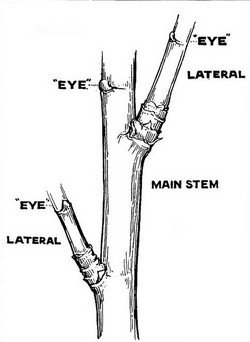
Parts of the Rose - Note the main stem this is also known as a "cane"
Aims and Objectives when Pruning Roses
1. Pruning to Shape your Roses Bushes:
2. Pruning for Space in your Rose Beds:
3. Pruning to Improve the Rose Blooms:
4. Pruning to Encourage Rose Growth:
5. Pruning to Prolong the Life of your Roses:
Most roses, if allowed to grow unpruned will produce new shoots off old wood and these will grow unheaded, until eventually the stems become harder and harder, more prone to disease, and over time the plant will die. By cutting out the dead wood, and reducing the old stems, new shoots are encouraged and the rose bushes will continue to grow for many more years.
How to Prune Roses the First Year after Planting
Roses planted in the fall should be pruned in the following spring.
Roses planted in the spring should be pruned at the time of planting.
Pruning Times for Roses
Dwarf and Standard Hybrid Perpetuals and Hybrid Tea Roses: Should be pruned during March.Dwarf and Standard Tea Roses and Noisettes: Should be pruned during April.
Climbing Varieties of Hybrid Perpetuals, Hybrid Teas and Noisettes: Should be thinned out after flowering and pruned during March.
|
Countryfarm
Lifestyles Tip:
When you go around pruning your roses carry with you a bottle of
methylated sprits. After you prune, dab the methylated spirits on to
the ends of the cuts. This will help prevent "die back" and kill fungal
diseases. It is also handy to pop on to any scratches you may see on
the wood to prevent infection. |
How to Prune Climbing Roses and Ramblers
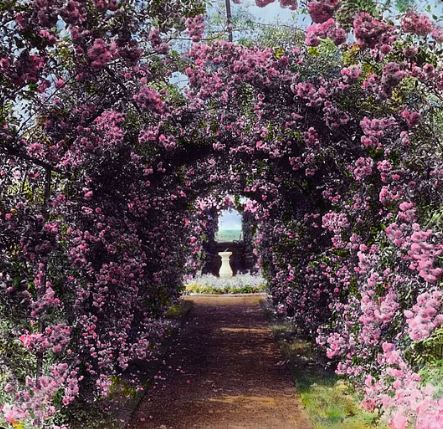
Climbing roses and ramblers are thinned out just after they have finished flowering and pruned in March. This pruning stimulates new cane growth and development of new laterals on which new flowers will form.
Rambling roses will produce basal shoots. These will produce flowers the following year on new stems. In turn, from the old wood, a number of other stems will grow.
When pruning climbers and ramblers you have to make the distinction between the laterals and the stems growing from the old wood and decide what you are going to cut out, as they often look the same.
If your new basal shoots look strong and vigorous with good length, then you can cut all the old wood out that has flowered. If however, you don't have good growth and length on your new shoots, then don't cut out the shoots from the old wood, but leave a good number of the strong shoots for future growth.
Old wood is useless to the roses unless it supports strong laterals from which new flowers will come. If you only have old wood, with weak or no laterals, then prune this wood by cutting it right out.
Where you are training ramblers to climb a trellis or a frame, you may find that one season's growth won't be enough to cover it. Just cut off some of the older shoots and shorten some of the stronger, vigorous canes. This pruning will encourage laterals to develop so that eventually, your ramblers will cover the area.
Just remember, only unproductive wood should be removed from climbing roses. Tie the last season's canes into a horizontal position pruning away any growth less than a pencil thickness. This will encourage flowering all the way along the canes. In successive years upright growths need only be shortened back to the flowering spurs.
The time to remove all the dead wood and weak growth is during spring. Prune sparingly now as if you prune too much, your roses will not flower as well as you may expect.
Many of the larger climbing roses, especially the ever blooming types, do not produce as much growth year, after year by comparison to other hardier climbers. As a result, any pruning here should not be done severely.
Usually, it is only until year 3 or 4 that you will have old wood in your climbing roses and ramblers that will need to be removed.
How to Prune Bush Roses
Bush roses prefer to be thinned out, rather than pruned. Damask roses should never be cut back. Just thin out when crowded and cut off the tips of you want to lightly prune and shape.Pruning bush roses should be done in the spring, just before growth starts. First, remove any dead wood. If canes have died, cut about 2 inches below the dark discolored area. If there are no live buds left on the dead wood, then remove the entire cane from the rose bush.
Next, cut out any weak growth, or any canes that are growing towards the center of the bush. If you find 2 branches crossing over, remove the weaker one.
Finally, shape the plant by cutting the stong canes to a uniform height. In mild climates, bush roses can be pruned to a height of 24-30 inches.
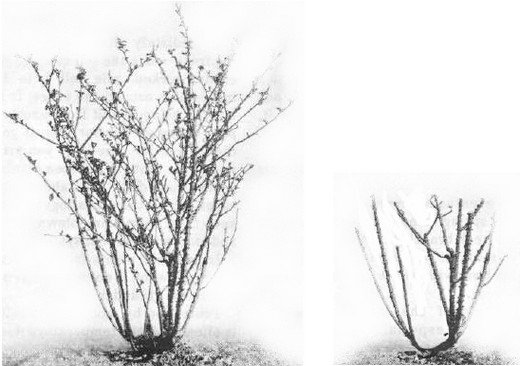
Here is a hybrid tea bush rose showing before and after pruning. Hopefully, you can pick out the main canes and laterals that have been kept to encourage good growth for the following spring.
How to Prune Rugosas
These old-fashioned roses should be pruned in February. The large rose hips that this variety is well-known for, will appear in the fall.Rugosas throw up a lot of suckers at the base of the rose plants, and so can keep the best of these of about 4 feet long. They will flower freely from these shoots.
You can either prune rugosas right back, or you can just thin them out, but each different way of pruning will give you a different result.
If you prune back hard, you will get a late flush of flowers the following year. If you just thin out some of the old wood, and just slightly shortening the shoots, then you will end up with a good flush of early flowers.
How to Prune Hybrid Tea Roses
These roses can be pruned in mid-March. Hybrid tea roses are many, and varied, and this then goes back to the earlier comments about knowing exactly what roses you have in your garden to decide how you are going to prune them.In the hybrid tea roses there are climbing roses, bedding roses, spreading roses, single roses and roses that are more related to China roses then the others. Each of which will need to be pruned differently.
How to Prune China Roses
The old pink, taller China Roses may be pruned early in March, the weaker varieties can be pruned in April.There are some varieties that do really well with a hard pruning where you can almost cut them to the ground and they will respond with a lovely show of flowers in the summer and fall, and there are others that do well with very little pruning. With these you just need to remove the dead flowers and cut out the dead wood.
Shoots may be left 5-6 feet long. The laterals on 3 year old wood should be shortened to 3-4 eyes, and some of the old wood removed.
For those China roses that you haven't hard pruned they will start flowering in May/June and continue to flower well into the summer.
How to Prune Wichuraiana
The wichuraiana is particularly useful to grow on pergolas, tall pillars, and excellent as weeping standards. Also good for covering walls and banks.Rose wichuraiana is an evergreen species that grows out horizontally right along the ground and sends out strong shoots from the base. "Dorothy Perkins" is a well-known rose from this variety.
It blooms towards the end of July when the plant has a number of bunches of single or double flowers.
This variety doesn't require much pruning, but does need a lot of thinning. Any pruning that is to be done, should be done in March.
There are some roses in this variety that have been modified by the Tea parent, and these bloom more on old wood. Therefore, more should be left and the laterals thinned and shortened.
How to Prune Standard Roses
If you have weeping standard roses there isn't much pruning to be done here. Keep the long growth, and remove any unnecessary shoots. Don't remove too many laterals as this is where your flowers will come from.Standard perpetuals and hybrid roses should be pruned in April making sure that they center of the rose plants are pruned to keep the center well open.
Cut back the shoots from the previous season, nearly to the point of last year's pruning so that you can maintain the shape that you want from your standard. Otherwise, if you don't you will end up with an unshapely head.
The weaker growing standard hybrid tea roses will require severe pruning. With these roses you can prune hard almost to the union.
In all cases any weak shoots should be removed.
Tasks to Do After Pruning your Roses
- Because roses carry a number of diseases on their leaves, it is better not to place these cuttings in your compost heap, but rather burn your rose prunings.
- Roses also love potash which can be naturally found in wood ash from your winter wood fires. Potash encourages good sturdy growth, hardens the young stems and helps to throw off and prevents mildew.
- Fork this mixture in lightly around the roots of the plants, but do this before mulching with some well-rotted farmyard manure just after pruning.
- Once new growth is underway an application of specially formulated rose food and a dressing of compost or manure will be the helping hand to ensure a new season full of bloom.
- When this is completed, give each rose bush a good spraying with a lime-sulphur mixture, allowing 20 parts of water to 1 part of lime sulphur.
- Then in the spring, when the bushes are covered with foliage, give another spraying with the same mixture.
- Be sure to do this second spraying in the cool of the evening. This will help protect the new foliage against disease. The strength now is 40 parts water to 1 part lime.
Final Word of Advice
Roses are hardy. They will soon bounce back, even if they have been badly pruned the season before, so don't be too afraid of giving pruning a go!Video on How to Prune Roses
You can Add your own Comments, Tips and Ideas on Pruning Roses Here!
We have lots of pages where you can contribute to throughout this website. We love hearing from our readers, and hope you will be one of those we hear from too. Look around our homesteading website. If you have some comments, tips and ideas about growing roses of your own, please submit them. All you need to do is type and submit. We will do the rest!
Leave a Comment
Do you have anything that you would like to add after reading this page? We would love to hear your thoughts. If you can add additional information to what has been written here you will be adding value to the website! No need to have any special skills - just type and submit. We will do the rest!
Other Comments
Click below to see comments from other visitors to this page...
very nice explanation on how to prune roses 



I would like to know when does one water the rose plants after pruning in the fall.
****
Nisa, after pruning your roses you need to make sure …




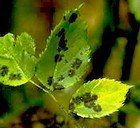

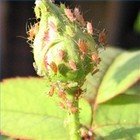




New! Comments
Do you have something of value to add? Leave me a comment in the box below.